Charge ordering in quasi onedimensional semiconductor NbSe43I - PowerPoint PPT Presentation
1 / 12
Title:
Charge ordering in quasi onedimensional semiconductor NbSe43I
Description:
... Nb: narrow band semiconductor ... pseudo Jahn-Teller effect in narrow band semiconductors. increase of LT gap ... (NbSe4)3I is not so narrow band semiconductor ... – PowerPoint PPT presentation
Number of Views:59
Avg rating:3.0/5.0
Title: Charge ordering in quasi onedimensional semiconductor NbSe43I
1
Charge ordering in quasi one-dimensional
semiconductor (NbSe4)3I
- D. Stareinic, K. Biljakovic
- Institute of Physics, Zagreb, Croatia
- P. Lunkenheimer, A. Loidl
- University of Augsburg, Germany
2
(MSe4)nI family
- M Ta, Nb (dz2 orbitals)
- n governs band filling
- n2,10/3 metallic with CDW below RT
- n3, MNb narrow band semiconductor at RT
- n3 6 Se4 rectrangles in unit cell without
screw symmetry
? gap in zone center
- Nb trimerization (CO) in addition
P. Gressier et al., Mat. Res., Bull. 20, 539
(1985) P. Gressier et al., Inorg. Chem. 23, 1221
(1984)
3
Structural transition at 274 K
- 2nd order displacive transition
- - relative shift of two chains
- - no center of symmetry
- pseudo Jahn-Teller effect in narrow band
semiconductors
? increase of LT gap
- intrachain Nb atom rearrangement
- only small kink in s(T)
P. Gressier et al., Mat. Res., Bull. 20, 539
(1985) T. Sekine, M. Izumi, Phys. Rev. B 38, 2012
(1988)
4
New results
- inexplicable features in optics and ARPES 1
- fs spectroscopy 2 incomplete phonon
softening at Tc
? purely electronic order parameter (central peak)
- huge thermopower changing sign at LT 3
1 V. Vescoli et al., Phys. Rev. Lett. 84, 1272
(2000).
2 D. Dvorek et al., submitted
3 M. Ocko, private communication
5
Dielectric spectrosopy
- broadband dielectric response 10 mHz - 100 MHz
- Wide temperature range 1.5 K - 300 K
- frequency-response analysis Novocontrol
a-analyzer - reflectometric technique impedance analyzer
Agilent 4294A - needle-shaped samples S 510-9 - 610-8 m2 l
0.9 4.5 mm - crystallographic c-direction
- no non-linear effects, no hysteresis
- Complex dielectric susceptibility e(n) from
complex conductivity s(n)
P. Lunkenheimer et al., Contemporary Physics 41,
15 (2000).
6
Low frequency dielectric response
- increase of Re e below Tc
- maximum at 150 K
- huge value at maximum
- strong dispersion
- similarity to relaxor ferroelectrics (dilute with
frustration and disorder) - similarity to isostructural CDW systems 1
1 T. Sekine et al., Physica B 143, 158 (1986).
7
Frequency dependence
- relaxational dynamics
- strong slowing down
- described by Cole-Cole
- De amplitude
- t0 relaxation time
- narrow distribution 1-a0.8
8
Characteristic parameters
- e? negligible, De follows low frequency Re e
- t0 activated growth with Dt0.11 eV
- nearly follows activated growth of rdc (Dr0.13
eV) - resembles the effect of free carrier screening
in CDW 1
1 P. B. Littlewood, Phys. Rev. B 36, 3108
(1987).
9
Wide temperature dc conductivity
- no narrow gap
- ? crossower between HT and LT activated regime 1
- Tc in the middle of the plateau
- DHT/DLT?3/2
- no nonlinear conductivity to 100 V/cm below RT
1 P. Gressier et al., J. Solid State Chem. 51,
141 (1984)
10
Structure evolution vs dc conductivity
- two stable distorted structures with different
nodal properties at the top of valence band 1
- very small stability difference
- continuous change from (i) to (ii) would give
qualitatively the measured r(T) - observed RT 2 and LT 3 structures corresond
to (i) and (ii) respectively
1 P. Gressier et al., Inorg. Chem. 23, 1221
(1984)
2 P. Gressier et al., Mat. Res., Bull. 20, 539
(1985) 3 M. Izumi et al., Synthetic Metals 19,
863 (1987)
11
JT distortion vs Nb displacement
- JT distortion selects the nodal properties at the
top of valence band
- Nb atoms do not follow immediately
- interchain ferroelectric interaction competing
with antiferroelectric structural ordering
12
Conclusion
- (NbSe4)3I is not so narrow band semiconductor
- transition from HT to LT activated regime
consistent with structural changes - JT transition does not rearrange Nb atoms within
the chain - Nb atoms rearrangement continuous in T
- high e and strong dispersion probably due to the
FE and AFE competition































